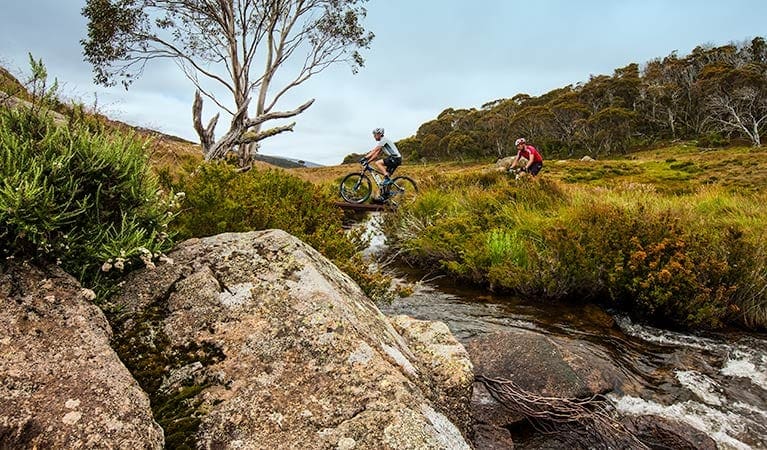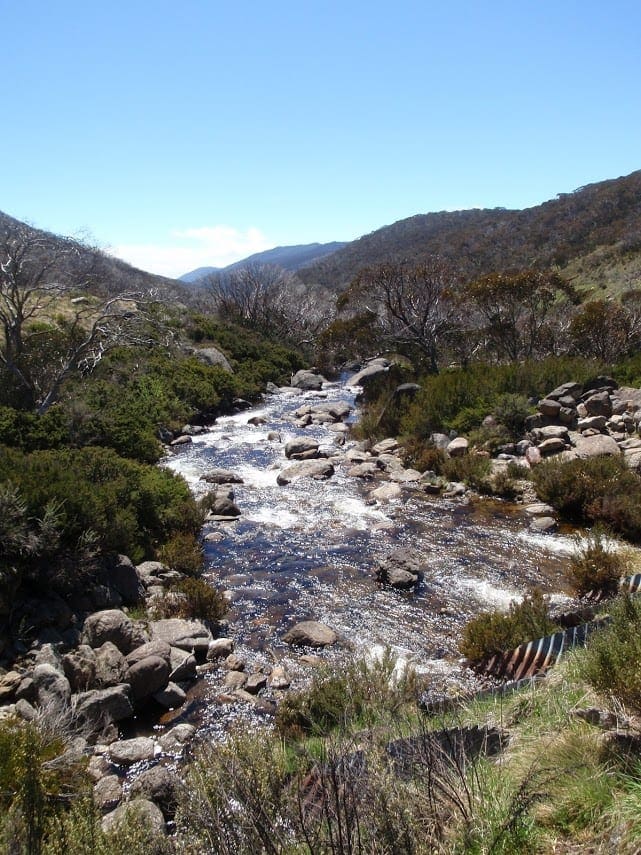Hike at a Glance
Max elevation: 855m
Min elevation: 795m
Total Ascent: 59m
Important info
It's important to note that while much of the Little River Gorge Walk is graded as Grade 2 (Easy), the track is given a Grade 3 (Moderate) rating overall due to its steep sections, as per the Australian Walking Track Grading System. These steeper parts require a bit more effort, but the rewards are well worth it, with spectacular views waiting at the lookout.
Hike overview
The Little River Gorge Walk is a rewarding yet challenging short hike, set within the stunning Snowy River National Park in Victoria. At 800 metres in length, this Grade 3 trail is steep in parts, making it a good choice for those seeking a bit of adventure. Typically taking around 30 minutes to complete, the walk leads you to one of the most impressive viewpoints in the region.
From the start, the track descends to the lookout, guiding you to a stunning vantage point over the Little River Gorge. Carved into the landscape over thousands of years, the gorge is a remarkable feature of the park, its deep ravine formed as the river carved its way through volcanic rock. As you make your way along the path, you'll be treated to awe-inspiring views of this natural wonder, with one of the ridgelines towering 600 metres high, making it Victoria’s deepest gorge.
What makes the Little River Gorge truly special is not just its depth, but the beauty of the surrounding landscape. The cliff-top views are dramatic and expansive, offering a unique perspective of East Gippsland’s rugged terrain. As the walk return back, the views remain just as impressive, making the return journey as memorable as the initial descent. This is a hidden gem of the region, a perfect destination for those looking to experience the raw beauty of Victoria's natural world.
Little River Gorge
Little River is a substantial waterway within the Snowy River catchment, situated in the alpine region of Victoria. It is one of two rivers bearing this name that feed into the Snowy River, the other being located in Kosciuszko National Park. Originating below Mount Stradbroke in a remote alpine wilderness within the Alpine National Park, the Little River flows generally southeast before re-entering the Alpine National Park and traversing the Snowy River National Park. Eventually, it merges with the Snowy River west of the Sugarloaf. Over its 27-kilometre course, the river descends 842 metres, carving a dramatic path through the landscape.
Little River is more than just a name; it is a geological force that has sculpted a profound gorge through the surrounding volcanic rock over millennia. At 600 metres deep, this gorge is Victoria's most substantial and remains a hidden gem of East Gippsland. While the river's upper reaches are contained within remote wilderness, the lower sections are more accessible. Parks Victoria has established facilities, including walking tracks and viewing platforms, allowing visitors to appreciate the gorge's grandeur without undertaking strenuous hikes.
The traditional custodians of the land encompassing the Little River are the Bidawal and Nindi-Ngudjam Ngarigu Monero peoples.
Gallery
Got some great shots from this hike? Upload your photos here to inspire others and show off the beauty of the trail!
Click to view form >>
Submitting your photos doesn’t mean you lose ownership. You can be credited for your contributions, and you can request removal at any time.
Content use
Please don’t copy GPX files or content from this site to AllTrails or other platforms. Each trail has been personally mapped, documented, and refined to support Australia’s bushwalking and hiking community. While some details come from land managers, every listing reflects significant personal effort. This is a free, community-driven initiative—your respect helps keep it that way.
Walk map and GPX file
Max elevation: 855 m
Min elevation: 795 m
Total climbing: 59 m
Total descent: -59 m
Getting there
Getting to the trailhead: Snowy River National Park.
To reach the Little River Gorge trailhead, drive approximately 67 kilometres north of Buchan. Follow Gelantipy Road out of Buchan and continue onto McKillops Road. The turn-off to the trailhead is clearly signposted.
Closest towns to this walk: Bendoc, Bonang, Buchan, Delegate, Ensay, Goongerah, Marlo, Orbost, Tubbut, Tubbutt
About the region
Snowy River National Park, located 390 kilometres east of Melbourne in Victoria, is renowned for its dramatic river landscapes, deep gorges, and diverse forests. Covering 98,700 hectares, the park safeguards one of Victoria’s largest forested areas. The park’s northern region is dominated by the Bowen Range and Gelantipy Plateau, while the rugged waterways of Mountain Creek and Rodger River flow southward into the Snowy River.
Established in 1992, the park encompasses two significant wilderness areas: Bowen and Snowy River. These protected regions offer exceptional conservation value and opportunities for solitary exploration. Visitors can engage in a range of self-reliant outdoor activities, although vehicular access to wilderness areas is restricted.
The park provides diverse experiences for outdoor enthusiasts. McKillops Bridge offers one of the few road access points to the Snowy River, where visitors can enjoy swimming in the river's clear pools or enjoy exciting canoeing or rafting adventures through rugged gorges and rapids. For those seeking a different kind of challenge, the 18-kilometre Silver Mine Walking Track and the shorter Snowy River Trail commence at McKillops Bridge.
Little River Gorge, Victoria’s deepest gorge, is a short drive from McKillops Bridge. A walking track leads to a lookout offering breathtaking views of the gorge. While the road to McKillops Bridge is not suitable for larger vehicles, visitors can explore the area by car under favourable conditions. The Yalmy Road winds through magnificent forests to Waratah Flat, providing opportunities for walks and hikes.
Raymond Falls, a stunning 20-metre waterfall, is accessible year-round from Orbost via Moresford Track. The park also features the 43-kilometre Deddick Trail, a four-wheel-drive route traversing the park's heart. Several camping grounds with varying amenities are available throughout the park.
Snowy River National Park is rich in natural and cultural heritage. Evidence of Aboriginal occupation has been found, suggesting that the Kruatungulung people of the Kurnai nation once thrived in the area. European settlement began in the 1840s with cattle grazing and mining activities. Despite early proposals, the park was not officially protected until 1979.
The park boasts exceptional biodiversity, with over 900 native plant species across 20 vegetation communities. Many of these species are rare or threatened. Wildlife enthusiasts may encounter superb lyrebirds along the Raymond Falls track, while azure kingfishers and even platypus can be spotted at the base of the falls.
Want to find the best trails in Snowy River National Park for an adventurous hike, casual walk, or a family trip? Trail Hiking Australia has the best trails for walking, hiking, running and more.
Similar walks nearby
Looking for more walks in or near Snowy River National Park? Try these trails with a similar difficulty grade.
Track grade
Grade 3 (Moderate) - Walks for Most Fitness Levels: Grade 3 on the AWTGS represents moderate walking tracks. These are ideal for walkers with some fitness who are comfortable with some hills and uneven terrain. While suitable for most ages, some bushwalking experience is recommended to ensure a safe and enjoyable experience. Tracks may have short, steep hill sections, a rough surface, and many steps. The total distance of a Grade 3 walk can be up to 20 kilometers.
Explore safe
Plan ahead and hike safely! Carry enough water, pack layers for changing conditions, and bring safety gear like a torch, PLB, and reliable communication device. Check official sources for trail updates, closures, and access requirements, and review local weather and bushfire advice. Most importantly, share your plans with someone before you go. Being prepared makes for a safer and more enjoyable hike! Stay Safe, Explore More, and Always #ExploreSafe.
Packing checklists
What you carry in your pack depends on factors like weather, terrain, and your adventure type. Not sure what to bring? My free planning, food, and packing checklists are a great starting point, covering day hikes, overnight trips, and multi-day adventures. Use them to customise your kit and always prioritise safety.
Let someone know
Before heading out, take a moment to fill out your trip intentions form. It’s a quick way to share your hike details with family or friends. If something goes wrong, they can notify emergency services, ensuring a faster response and peace of mind. Stay safe and enjoy your adventure
Suggest an edit
Spotted a change on this trail? Maybe there are new features, the route has shifted, or the trail is permanently closed. Whatever the update, I’d love your input. Your feedback helps fellow hikers stay informed and ensures that our trail info stays fresh and reliable.
Acknowledgement of Country
Trail Hiking Australia acknowledges the Traditional Owners of the lands on which we hike and pay respects to their Elders, past and present, and we acknowledge the First Nations people of other communities who may be here today.







10 Reviews on “Little River Gorge Walk (800m)”
Erryn Stephensaddd it to your list?
Not grade 3 though and the path is in great condition.
Peter Jolly land managers have graded this 2-3. As it has some steep sections the grade it carries relates to the most challenging aspect (grade 3) according to the AWTGS.
I think the most i recorded on that was 12 degrees, but i think it was where one of the water cuts had been made like they do on dirt tracks. You could walk down it in thongs to be honest.
But then, who am I to rate them, I crawled up a 50 degree un tracked spur on the weekend rather than use a track that was 500mtrs further along.
Peter Jolly the grades can be subjective and who really knows if they visited the track before grading it. I try to follow land managers grading where they exist and include notes, like the one on the hike that says it’s predominantly grade 2. It’s really not a lot of elevation change so I don’t disagree with you.
Thanks Peter. Land managers have graded this 2-3. As it has some steep sections the grade it carries relates to the most challenging aspect (grade 3) according to the AWTGS. Gradings like this can sometimes be misleading so I’ve included a note at the start of the walk to address this.
Nice little walk and a beautiful lookout 👌
James Lukassen totally agree.
This is a very cool gorge. Well worth the visit if you are in the area as its a long drive for such a short walk otherwise.